#louisa margarett
Text
Marx Christian Price
Marx Christian was born in Germany in 1833. 1852 was listed as his year of immigration from Germany. Due to the year of emigration he was most likely between 18 and 23 years old. He first settled in Brooklyn, NY.
His first marriage was on November 27, 1855 to Elizabeth Staats (born in Brooklyn, New York). Their children were: Wilhen Ludwig Price, born October 4, 1856, died November 14, 1880; George Christian Price, born January 2, 1858 in Brooklyn NY, died May 8, 1908, in Reading, Berks , PA, at age 50, buried at Woodlands Cemetery. George's occupation listed him as a "heater setter", Christian Price in entry for George Price, 1908; Heinrich Leopold Price, born March 20, 1860; Philipa Analie Price, born February 5, 1862; Elizabeth Price died on November 30, 1867.
Upon Elizabeth’s death, Marx Christian married Charlotte Catharina Geist in Philadelphia, PA, on May 5, 1868. Charlotte was born in Deutschland (Germany) on Aug. 25, 1843. Based on the year she left Germany for Philadelphia she was probably between 3-4 years old (between 1848 - 1850). Charlotte was around 20 years old when she married Marx Christian who was between 32-34 years old.
Marx Christian and Charlotte lived in Philadelphia PA: (February 13, 1900 census: Charlotte and Christian Price, 2100 Diamond Street, Ward 32, Philadelphia, Pennsylvania). Marx Christian's occupation was a merchant and tavern owner (1900 US Federal Census, Philadelphia, Pennsylvania).
Their children were: Friederich Leonhardt Price May 29, 1869; Sophia Augusta Price, born August 24, 1870 (n the 1900 Census, Sophia Price was age 30); Robert William Price, August 8, 1871; Charles Friederick Price, born March 17, 1873 in Philadelphia, PA, died June 20, 1909, in Philadelphia, Pennsylvania. Charles was 36, single, and occupation was listed as "Adv. Solicitor N.A". Burial date: June 23, 1909. Charles is buried at Woodlands Cemetery. Christian Price in entry for Charles F. Price, 1909.); buried 1908 Woodlands Cemetery, Philadelphia, PA, USA; Walter Scott Price Sr., born September 26, 1876, died March 18, age 68 in 1945; Lillian Estelle Price, born March 21, 1879 (Married name: Howser. In the 1900 Census, Lillian Price was 21); Margarette Louisa Price, born June 18, 1880, died July 1, 1880.
Charlotte died on February 13, 1910, age 66 years old, in Philadelphia, Philadelphia County, Pennsylvania, USA. She is buried in Woodlands Cemetery, I 665, Philadelphia, Philadelphia County, Pennsylvania, USA (findagrave Memorial ID 97310205). Her obituary read as Charlotte C Price (Charlotte Geist), Mother: Charlotte C; Father: Louie Geist (From the Philadelphia, Pennsylvania, Death Certificates Index, 1803-1915). Her obituary from the Philadelphia Inquirer reads: "Charlotte C. Geist Price, 66y 6m 20d, Married, Daughter of Louie and Charlotte C. Geist, 2100 Diamond Street, 32nd Ward". Philadelphia Inquirer, Feb. 15, 1910: "PRICE - On February 13, 1910, CHARLOTTE C., wife of Christian Price, aged 66 years. Relatives and friends invited to attend the funeral services, at her husband's residence, 2100 Diamond street, on Wednesday, at 2 P. M. Interment at Woodlands Cemetery. Burial: Woodlands Cemetery, Philadelphia, Philadelphia County, Pennsylvania, USA."
(Marx) Christian Price was 76 and widowed in 1910 when the 1900 US Federal Census was conducted.
Sources:
-ancestry.com: a 1900 US Federal Census in Philadelphia, Pennsylvania
-familysearch.org: United States Census, 1900, Household of Christian Price, Philadelphia city Ward 32, Philadelphia, Pennsylvania, United States.
-familysearch.org: Philadelphia City Death Certificates, 1803-1915
-The Marx Christian - Charlotte Geist Price Family Plot in Philadelphia, PA. Marx Christian's burial site was listed in the census records. The plot map and internment records were provided by Woodlands Cemetery, Philadelphia, Philadelphia County, Pennsylvania, USA.
#Marx Christian Price#Walter Scott Price#Walter Scott Price Family History#Price Mansion#Price Mansion Philippines#Charlotte Geist
0 notes
Text
The Eerie Fashions of WWII Europe
I discovered some of these images while I was doing visual research to costume Caryl Churchill’s play Far Away, a dystopian vision of a world fragmented into factions, with every aspect of the environment both human, animal, and elemental at war with each other. These images explore European women’s fashion during World War II, when the Blitz bombings required that people wear gas masks when out in public, resulting in an other-worldly clash between the routine and the apocalyptic. Fashion quickly caught up, and a handbag which included a respirator was issued for the discerning woman who didn’t care to carry her respirator in the typical cardboard box with a string. The siren suit, a front-zipping jumpsuit which could be quickly put on over pajamas or a nightgown should the bomb siren sound at night, became popular. Though men’s style siren suits were similar to a traditional jumpsuit, women’s styles were more figure-flattering and fashion-forward, while children’s suits were often knitted and adorably elfin.
What draws me to these images is their distinct ominousness; the way in which the obvious crisis of mortality has been seamlessly folded into the comings and goings of everyday life and repackaged as a commodity. I’m intrigued by the retro-futurism of the siren suits, which turn the women who wore them into a hyper-stylized blend of a manual laborer, fighter pilot, and biohazard cleanup team. Here again we see the fashion world rushing in to soothe the consciousness of a woman in danger of being ripped out of bed in the middle of the night by a bomb threat by selling her vulnerability to her as an opportunity to showcase her personal style and taste. Capitalism to the rescue again! But I take their point. To don a piece of clothing provokes an innate emotional response; the right outfit can feel like a supersuit, and if that’s what these women need, then bring on the designer siren suits.
In these images I sense a prevailing attitude that appearances must be kept up no matter the circumstances-- life goes on! Stripped of their context, though, they make for a disorienting and dystopian sight, speaking to our chilling capacity to adapt to ignore what is right under, or on, our noses.
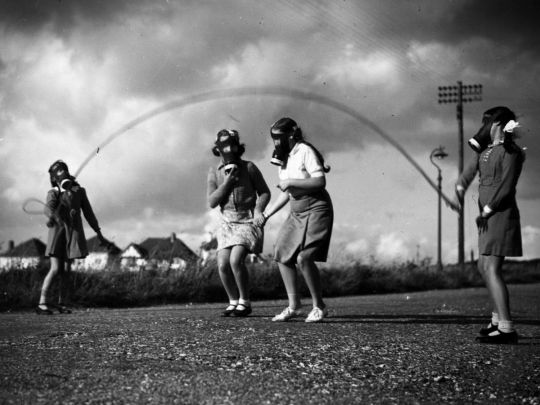
Schoolchildren in London circa 1940 (General Photographic Agency/Getty Images)

Music hall dancer in gas mask and helmet, 1940 (Keystone France via Getty Images)

Dorothy Farrington and friend in gas masks, circa 1944 (The Betty H. Carter Womens Veterans Historical Project, UNCG Digital Collections)

Siren Suit (Getty Images)
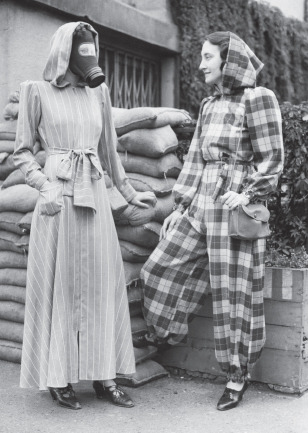
English designs for a siren suit and a hooded coat, autumn 1939 (via Forties Fashion by Johnathan Walford)
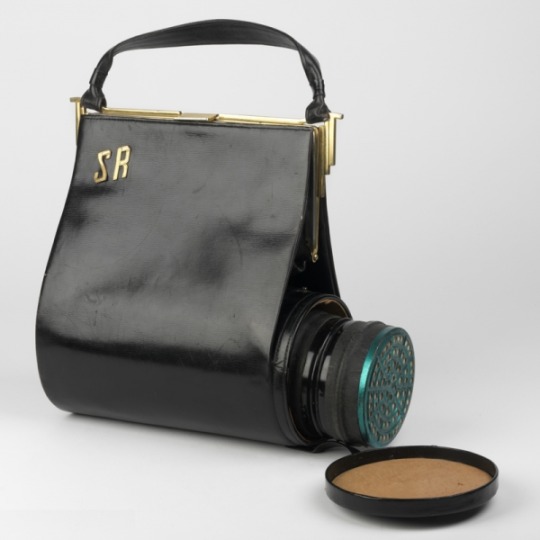
Respirator purse (via International War Museum archive)

Siren suit, 1941 (via International War Museum archive)
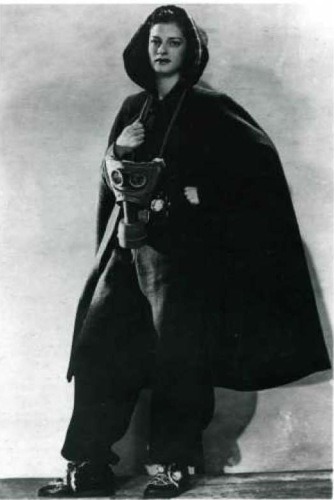
Siren Suit designed by Elsa Schiaparelli, 1938 (via Met Museum archive)
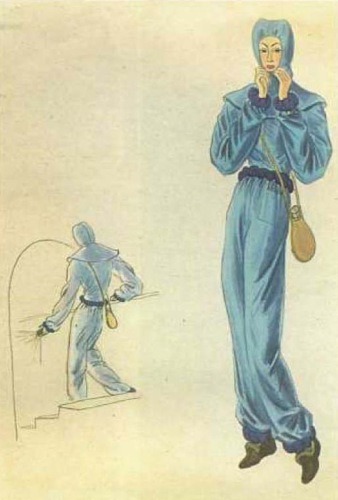
Designs for a siren suit by Elsa Schiaparelli, circa 1940 (via Dejavu Team)
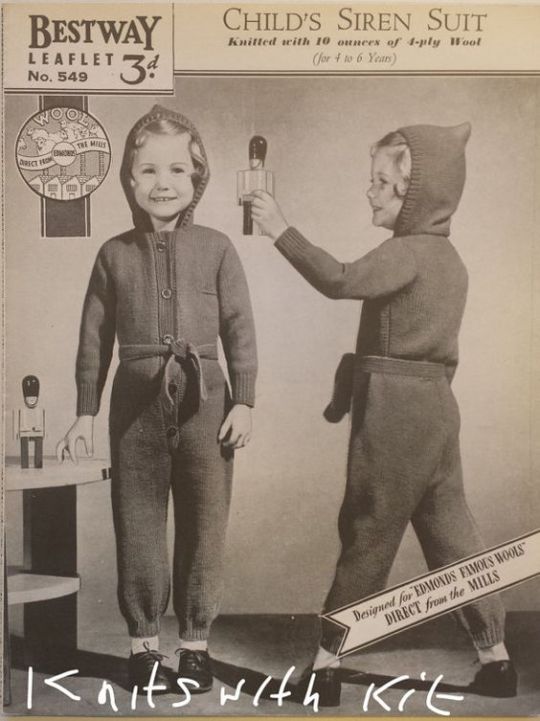
Siren suit advertisement for children (via CUNY Academic Commons)
#fashion#historic fashion#fashion history#dystopian#world war 2#world war ii#gas mask#siren suit#secondlookblog#second look blog#louisa margarett#louisa mascuch
1 note
·
View note
Text
New Collections, 2019-05-07
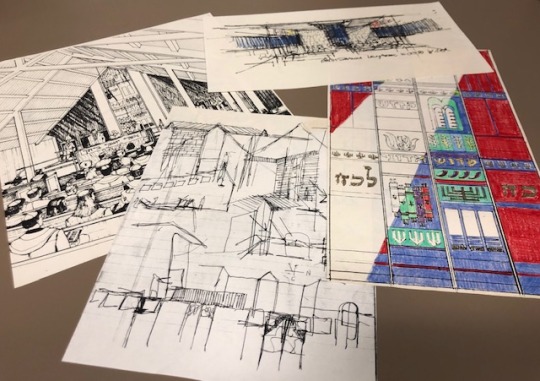
Morton and Jean Levy papers, MS 845
The collection consists of one box containing a scrapbook of, primarily, Morton Levy's architectural drawings of the proposed renovation to Congregation Brith Shalom's interior, correspondence, news clippings, and photographs of the congregation's interior from 1986-1996. In addition to the drawings in the scrapbook there are ten prints from Levy's portfolio (1997) of a number of synagogues that he worked on. The rest of the material -- two Congregation Beth Israel bulletins, news clippings, and two group photographs of Barnston B.B.G. members -- is from 1948 to 1954.
Morton Levy, a native Houstonian, graduated from high school in 1951. He received his Bachelor of Arts degree from Rice Institute in 1955 and his Bachelor of Science in Architecture, with distinction, from Rice in 1956. He founded his own architectural practice in 1963 and was licensed to practice architecture in Texas from 1960 through 2014. The resume for his award-winning practice includes service as architectural consultant to the U.S. Postal Service for thirteen years, eighteen projects for the City of Houston Department of Health and Human Services, four projects for the Houston Independent School District, seven Houston area synagogues, and eight renovation/expansion projects for the Houston Jewish Community Center. He retired in 2015.
Jean Merle Kanowitz Levy is a native of Pittsburgh, Pennsylvania, but moved with her family to Houston at the age of nine. A graduate of San Jacinto High School in Houston, Jean went on to receive a degree in Liberal Arts Studies from the University of Houston. Morton and Jean married in 1960 and have three children: Nanette (1961), Jay (1965), and Lisa (1966).

Shearith Israel Congregation collection, MS 738
The collection contains six boxes of correspondence, event materials (including programs, correspondence, and memorabilia), newsletters, bulletins, news clippings, books, photographs, financial documents, sermons, and video and audio material of events that document the history of Shearith Israel Congregation in Wharton, Texas, from 1921 to 2002.
Shearith Israel Congregation had its inception in 1899 when the Jewish citizens of Wharton, Texas, first met to conduct religious services, using members' homes as meeting places. As the community grew and the number of Jewish families increased plans were formulated for the building of a Synagogue. At first the membership consisted mainly of Wharton citizens, but as the Jewish population increased in surrounding towns the congregation expanded to include those who lived nearby from El Campo, Bay City, Ganado, Edna, Palacios, and Richmond. A tract of 2.14 acres was purchased and the building was completed in the fall of 1940. In 1956, the community dedicated a new, state-of-the-art synagogue building in the shape of a six-pointed Star of David at 1821 Old Lane City Rd., designed by Houston Jewish architect, Lenard Gabert. Perhaps, the most notable and enduring feature of the property, however, was the barbecue pit. Shearith Israel’s annual barbecue fundraiser, the social event of the year for the community, attracted hundreds of Jews and non-Jews from the area, as well as relatives and former members, who descended upon Wharton to eat chicken and cole slaw. The synagogue closed its doors in 2002, when membership dwindled from a peak of 400 members down to just 39, and sold its facilities. In 2010, the main building burned to the ground, and, besides the community hall that still stands, visitors to the site today will see nothing but a concrete slab where the sanctuary and school once stood.
Herman and Margarett Root Brown Family papers, MS 697
The collection consists of a range of keepsakes memorializing the lives of Herman and Margaret Root Brown and their family. The oldest in time are the high school senior class yearbook of Herman Brown and a framed loan document bearing his signature. There are many photographs, both formal portraits and small snapshots as well as intermediate size pictures. Among the people featured in addition to Herman, Margaret, and their children are the mother and sisters of Herman and George Brown, the wife and daughters of George, and some business associates.
Herman Brown, born in Belton, Texas in 1892, and Margaret Root, born in 1895, were married in 1917. Having begun doing construction work in Belton in 1914 and being paid in used equipment and mules, Herman formed a business which his brother-in-law Dan Root joined in 1919. They were in turn joined by Herman’s younger brother George in 1922. For the first twenty years their work was primarily road paving and bridge building throughout Texas. In 1942, with federal government involvement through freshman congressman Lyndon Baines Johnson, they completed a 1.3-mile-long dam near Austin.
World War II prompted the company’s expansion into ship-building, and it produced 359 destroyer escorts and other ship types. After the war Brown and Root expanded by acquiring (for $143 million) the U.S. government’s Big Inch and Little Big Inch pipelines (originally built to replace tanker ships vulnerable to German submarines).
In 1951 Herman and George Brown and their wives set up the Brown Foundation, which has made large gifts beginning with Rice University, Southwestern University (Margaret Root Brown’s alma mater), and the Museum of Fine Arts, Houston.
Two children joined the family of Herman and Margaret Brown, who had no children of their own. Louisa and Michael Stude were adopted and raised by the Browns but kept their birth names because their natural parents were still living.
Herman Brown died on November 15, 1962, and Margaret followed in 1963. To honor the memory of Margaret, George Brown and his wife Alice donated funds used to establish a residential college at Rice University. Margaret Root Brown College was dedicated October 3, 1965.
#congregation brith shalom#houston jewish history#houston jewish history archive#jean levy#lenard gabert#morton levy#shearith israel congregation#wharton#herman brown#margaret root brown#george brown#lyndon baines johnson#lbj#brown and root#special collections#rice university
3 notes
·
View notes